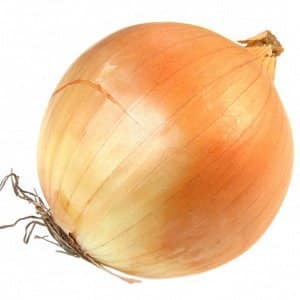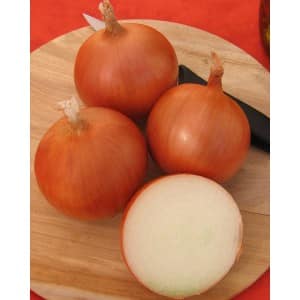Multi-primed onion hybrid “Manas”, which tolerates drought well
Manas onion is a hybrid of Dutch selection that has gained popularity among farmers due to a lot of positive characteristics, among which are especially high yield, good keeping quality, the possibility of universal use and growing on feathers.
Description of the hybrid
Manas is a first generation hybrid. The bulbs are suitable for use fresh, for drying and as an additive to various dishes and preserves.
Manas onion is the result of the work of Dutch breeders. The originator is BEJO ZADEN B.V.
The hybrid was included in the Russian state register in 2008.
Chemical composition, trace elements and vitamins and beneficial properties
The Manas onion contains:
- micro- and macroelements;

- essential oils;
- proteins;
- sugar;
- carbohydrates;
- mineral salts;
- vitamins PP, C, group B.
Regular consumption of onions helps burn fat, remove cholesterol and destroy blood clots, reduces the risk of developing cancer and cardiovascular diseases, and protects the body from viruses and bacteria.
Ripening time and yield
This is a late-ripening onion - 110-120 days pass between the appearance of mass shoots and the onset of technical maturity.
Marketable yield is 392-550 c/ha.
The hybrid is resistant to fusarium, pink rot and downy mildew.
Characteristics of the bulb, description of appearance, taste
Manas is a multi-bud onion, so it is well suited for growing on feathers, which are dark green in color and covered with a waxy coating.
Reference. Once the feathers are cut, the onion is not suitable for bulb production.
The bulbs have a neck of medium thickness, round, weigh 85-100 g, and are covered with three dark brown dry scales.
The pulp is white with a greenish tint, juicy, crispy. The taste is semi-sharp.
For which regions is it best suited and what are the climate requirements?
The hybrid is included in the state register for the Central, North Caucasus and Lower Volga regions.
Manas adapts well to different climatic conditions, but the highest yield is observed in a dry continental climate.
The main advantages and disadvantages of a hybrid
Advantages of a hybrid:
- high productivity;

- resistance to characteristic diseases, pests and drought;
- pleasant taste;
- versatility of use;
- long-term storage;
- possibility of growing on a feather.
Minuses:
- low resistance to frost;
- impossibility of obtaining your own seeds.
What is the difference from others
Comparison of Manas with other hybrids in the table:
| Hybrid | Ripening period | Productivity, c/ha | Bulb shape | Bulb weight, g | Taste |
| Manas | Late ripening | 392-550 | Round | 85-100 | Peninsular |
| Mannito | Mid-late | 153-204 | Round | 60-90 | Peninsular |
| Marco | Mid-late | 155-286 | Round | 60-80 | Spicy |
| Nerato | Late ripening | 260-310 | Round | 75-90 | Peninsular |
Features of planting and growing
Manas onion is grown from seeds. In the southern regions, they can be sown directly into beds, but the seedling method is more reliable, since in open ground it is difficult to create and maintain optimal conditions for the hybrid.
Preparing for landing
There are several ways to prepare planting material:
- disinfection – seeds for 40-45 minutes. soaked in a solution of potassium permanganate;
- warming up - first the seeds are immersed in hot (+50°C) water for half an hour, and then for 2-3 minutes. in the cold;
- bubbling - planting material is placed in a jar of water into which air is supplied from a compressor;
- stimulation - seeds are soaked for 18-20 hours in a solution of growth stimulants.
After processing, the seeds are wrapped in cloth and placed in a container with water for 24 hours, changing it every 6-8 hours. Then they are laid out between two wet wipes and put away in a warm place for several days. Sprouted seeds can be planted.
Reference. Seeds no older than two years old are suitable for sowing.
In the fall, the soil on the site is dug up and cleared of plant remains. River sand and sawdust treated with urea are added to clay soil, and lime is added to highly acidic soil.
in spring the soil is fertilized with ammonium nitrate, leveled and slightly compacted, and then watered with hot (+50°C) water and covered with polyethylene for 2-3 days.
Soil requirements
Manas grows well in loose, fertile soil with good moisture and air permeability and a neutral acidity level (pH 6.0-7.0).
Dates, scheme and rules of planting
Seeds for seedlings are sown in the first half of February according to the following scheme:
- Pour nutrient soil into previously prepared containers.
- Make furrows in the soil, keeping a distance of 5-6 cm between them.
- Place planting material in them at the rate of 15-20 g of seeds per 1 square meter. m.
First, the container with seeds is kept at a temperature of +18...+25°C, and after germination it is reduced to +15...+16°C.
Reference. For better growth and development, plants are fed with bird droppings diluted in water or complex fertilizers.
The seedlings are transplanted into open ground 50-60 days after emergence, when the seedlings have 3-4 leaves and a developed root system.
Transplant process:
- Prepare beds on the site with a row spacing of 45-60 cm.
- Make planting holes in them every 15-20 cm.
- Water the seedlings generously, remove the seedlings from the container and place them in the holes, burying them 1 cm deeper than they grew previously, and making sure that the roots do not curl up.
For better adaptation in open ground, the leaves are cut off by a third from the seedlings and the roots are trimmed.
Features of cultivation
The area where Manas grows should be well lit, protected from the wind and located on a hill, since the accumulation of moisture in the lowlands provokes the development of diseases.
You should not plant onions after carrots and garlic; the best predecessors are legumes, cabbage, potatoes, tomatoes, cucumbers, and zucchini.
Seeds can germinate at a temperature of +1...+2°C, but the optimal temperature is +18...+20°C. The roots actively grow at +10...+15°C, and the green part - at +18...+20°C.
Nuances of care
To obtain a high-quality harvest, it is necessary to provide the plants with proper care.
Within a month after landings Onions are watered in open ground every three days, then once every 7-10 days. When watering, they are guided by the condition of the soil - it should be moist to a depth of 30 cm.
20-28 days before harvesting, watering is stopped.
Loosening the soil and weeding
To improve access of water and air to plants, the soil is loosened after watering to a depth of approximately 5-6 cm. At the same time as loosening, weeds are removed from the soil, which interfere with the development of vegetables, taking moisture and nutrients from the soil.
During the growing season, the soil is loosened at least four times, the last time a month before harvest.
Top dressing
Fertilizer application scheme:
- 20 days after planting the seedlings in the beds, mix manure or chicken droppings with water (1:10), add 25 g of urea to 10 liters of the resulting solution. Fertilizer consumption – 10 sq.m. bucket. m.
- In mid-July - phosphorus and potassium fertilizers. This helps the bulbs accumulate carbohydrates, which has a positive effect on the speed of their ripening and keeping quality.
If Manas is grown for feathers, then ammonium nitrate is used as fertilizing, which is applied immediately after cutting the greens and two weeks after that.
Disease and pest control
If onions grow in unfavorable climatic conditions, as well as in case of non-compliance with agrotechnical requirements, Possible damage to the following diseases:
- powdery mildew - treated with fungicidal preparations;
- gray rot - for prevention, the soil is treated with Bordeaux mixture and nitrogen-containing fertilizers are applied, plants affected by the disease are disposed of;
- mosaic – the disease cannot be treated.
Among the pests, onion flies pose the greatest danger to the hybrid. To combat this insect, spray the plants monthly, but no more than three times, with a solution of salt or ammonia so that it does not get on the leaves.
Harvest and storage
In order for the crop to be stored for a long time and not lose its presentation and beneficial properties, it is important to remove it from the beds in time and create the proper conditions storage.
How and when to collect
The bulbs are harvested from late July to early August, carefully digging them up and pulling them out of the ground. Greens are cut up to four times per season.
Storage features and shelf life of the hybrid

Fresh greens are stored for only a few days; for longer storage, they are frozen by first cutting them and placing them in small containers and bags.
After digging, the bulbs are laid out in the sun or under a canopy and dried for 15 days. Then they are inspected, all damaged specimens are removed, placed in boxes or bags and put in a cool room with a humidity of 75-90% and an air temperature of 0...+1°C. Onions can also be stored in an apartment at a temperature of +18...+20°C and a humidity of 50-70%.
In such conditions, the crop is stored for 6-9 months.
What difficulties may there be when growing
Problems that may arise when growing Manas:
- slow feather growth – air temperature above +25°C;
- powdery mildew due to excessive humidity;
- Slow ripening of onions is the result of hilling, which cannot be carried out.
Advice from experienced gardeners
Farmers who have been growing Manas onions for a long time recommend:
- A few weeks before harvesting, rake the soil away from the bulbs - this will encourage the formation of larger bulb heads.
- If harvest time is close, but the feathers are still green and the neck is thick, then a week before harvesting, cut the roots with a shovel 5-6 cm below the bulb.
- When growing onions for plumes, grow the greens no more than 40 cm - they turn out juicy and without bitterness.
Reviews of the onion hybrid Manas
Experienced gardeners speak positively about the Manas onion:
Mikhail, Saratov region: “I liked this onion for its high yield and long-term storage - I don’t remember a year when the crop was stored for less than 7 months. I have been growing Manas for six years now and have no plans to change it to another variety. True, I would not recommend it to those who rarely visit the dacha, because you need to water the onions often, especially in the first half of the growing season.”
Ivan, Nizhny Novgorod region: “The main criteria by which I evaluate onions are yield, keeping quality and taste.Manas meets all my requirements - it produces a bountiful harvest, is stored for a very long time and does not taste too spicy.”
Conclusion
Manas onions can be grown to produce both bulbs and greens. The hybrid adapts to any climatic conditions, is resistant to pests and diseases and does not have serious maintenance requirements, with the exception of regular watering.